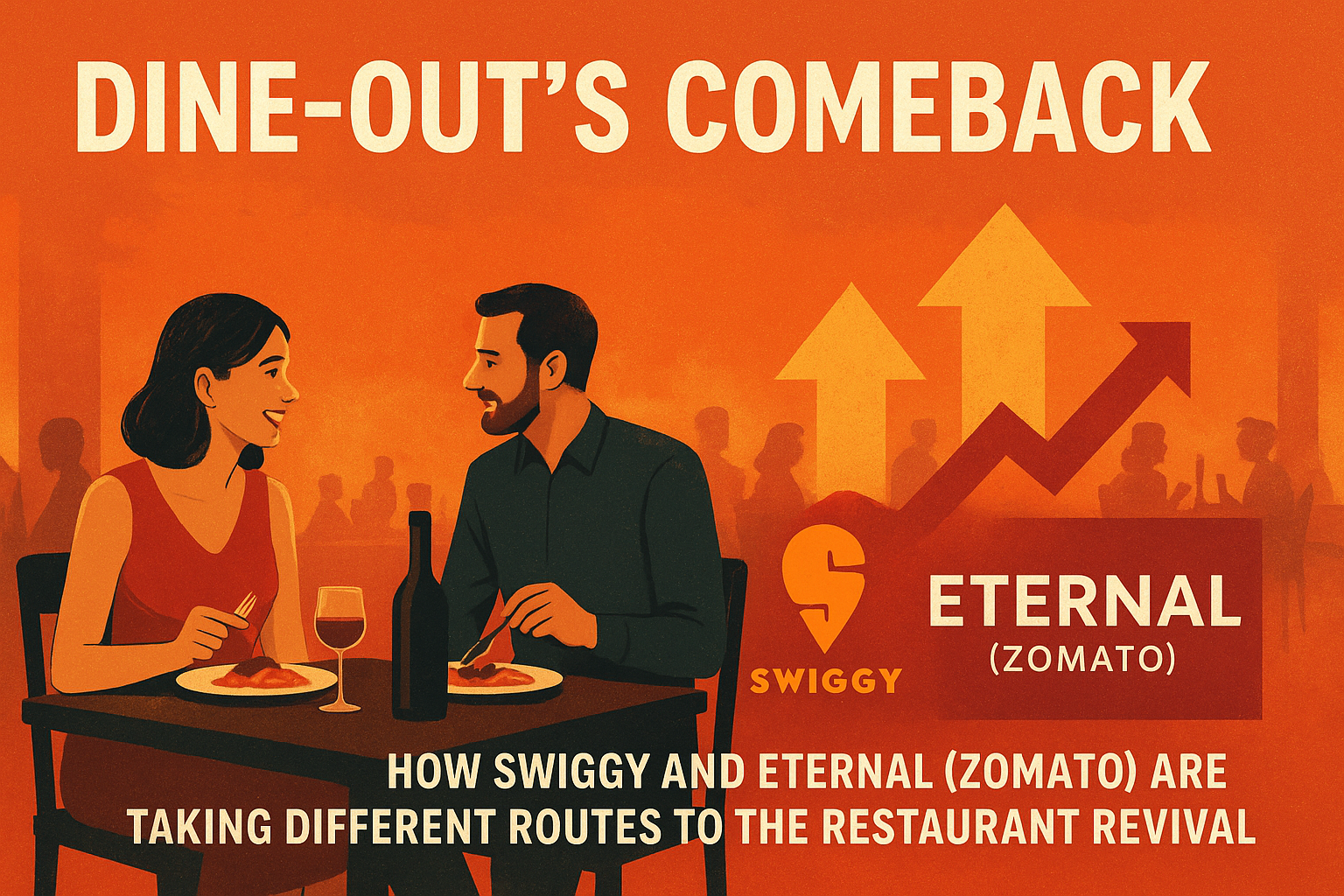The restaurant tables are filling up again. After years of home deliveries dominating India’s food-tech narrative, dine-out is back in fashion. But the revival is not just about consumers returning to their favourite eateries—it’s about how India’s food-tech giants, Swiggy and Eternal (Zomato), are positioning themselves for the next growth cycle. One is chasing profitability; the other, scale. Both are racing to define what the post-pandemic dining experience looks like.
Swiggy Turns the Profit Corner
For the first time, Swiggy’s dine-out arm has turned profitable. The company clocked a Gross Order Value (GOV) of ₹1,118 crore in Q2 FY26, a 52% year-on-year jump from ₹734 crore in the same quarter last year. Its adjusted Ebitda margin of +0.5%, translating to an operating profit of ₹6 crore, signals a crucial milestone after multiple loss-making quarters.
Swiggy’s focus on a narrower, more disciplined vertical—centered on dining rather than broader events or retail—is beginning to pay off. While its revenue from operations at ₹88 crore in Q2 FY26 may seem modest, it reflects the company’s leaner structure and emphasis on profitability over breadth.
Eternal (Zomato) Expands Its Table
Eternal (Zomato), by contrast, is playing the long game. Its ‘District’ vertical—an umbrella for dining, events, and retail—posted Net Order Value (NOV) growth of 32% year-on-year, reaching ₹189 crore in revenue for Q2 FY26. However, it remains in the red, with a −3.1% Ebitda margin and a quarterly loss of ₹63 crore.
Zomato’s broader play means higher operational costs but also a diversified revenue base. Its numbers reflect ambition: scale before profit. The company uses NOV instead of GOV, deducting partner commissions and discounts to portray what it calls a truer picture of platform economics. This strategic distinction underscores Zomato’s view that ecosystem growth—restaurants, retail, and entertainment—will fuel future profits.
The Drivers of the Dine-Out Revival
The dine-out resurgence is being propelled by a mix of macroeconomic and behavioural factors. Office reopenings, consumer premiumisation, and a renewed appetite for social experiences are boosting traffic to restaurants. “The pickup is partly macro and partly behavioural, with loyalty programmes driving repeat visits,” says Sandeep Abhange, analyst at LKP Securities.
Importantly, both platforms say their dine-out segments now contribute 10–15% of overall business, marking a meaningful diversification away from pure delivery.
A Question of Margins and Momentum
Restaurants are welcoming the change too. Dine-in brings better margins since there’s no aggregator commission. “Consumers are in direct touch with the outlet, giving restaurants more leverage,” notes Pranav Rungta of the NRAI, though he cautions that aggregators still drive deep discounting to lure customers.
The GST rationalisation has also nudged profitability upward. Organised restaurants, especially quick-service formats, report 1–2% savings on inputs taxed earlier at 12%. It’s not a game-changer, but it helps.
Still, analysts warn that much of the current momentum is incentive-driven, not purely organic. “Discounts have risen consistently over the past two years,” says Karan Taurani of Elara Capital, calling the growth “largely incentive-led.”
Behaviour Shift: Dining as an Experience Again
What’s clear is that consumer behaviour is shifting. According to Sagar Daryani, president of NRAI, “the same customer who ordered online every 45–60 days is now returning to their favourite QSR every 30–35 days.”
Dine-out transactions also yield higher average order values (₹1,600–₹2,200 per guest), rising further with cocktails and weekend family bundles. Restaurateur Zorawar Kalra points out that dine-out gives brands more negotiating power—from rent to supplier contracts—and allows a recalibration of pricing versus delivery.
Swiggy vs. Eternal: Divergent Strategies, Shared Challenge
While Swiggy celebrates its first profitable quarter, Zomato’s losses stem from its bigger bets—diversified business lines that may take longer to mature.
Swiggy’s focus on a lean dine-out model may offer near-term stability, but it risks ceding ground to Eternal’s integrated approach once consumer demand stabilises.
For now, the combined dine-out Gross Order Value for both platforms stood at ₹3,588 crore in Q1 FY26, up nearly 39% year-on-year, according to Datum Intelligence. The pace, however, is flattening, as urban consumers rebalance their spending between eating out, home delivery, and quick-commerce.
Takeaways: Dining Is Back, But With Caveats
- Swiggy’s dine-out business has achieved profitability, focusing on a tighter operational model.
- Eternal (Zomato) is still loss-making but scaling faster, leveraging its multi-vertical ‘District’ ecosystem.
- Macroeconomic tailwinds and behavioural shifts are reviving restaurant footfalls, though much of the traction remains discount-driven.
- Restaurants gain higher margins and leverage in dine-in, but aggregators continue to influence pricing and customer acquisition.
- Sustainability remains uncertain, as long-term profitability depends on whether consumers keep dining out once discounts fade.
Conclusion: A Seat at the Table, Again
The dine-out recovery is not just a blip—it’s a sign that India’s urban consumers are seeking connection, not just convenience. But for Swiggy and Eternal, the road ahead is less about who wins more diners and more about who can make dining profitable at scale.
In the food-tech world, the meal is far from over—but for now, the tables are filling up again.
Feel free to share your experiences and insights in the comments below. Let’s continue the conversation and grow together as a community of traders and analysts.
By sharing this experience and insights, I hope to contribute to the collective knowledge of our professional community, encouraging a culture of strategic thinking and informed decision-making.
As always, thorough research and risk management are crucial. The dynamic nature of financial markets demands vigilance, agility, and a deep understanding of the tools at your disposal. Here’s to profitable trading and navigating the election season with confidence!
Ready to stay ahead of market trends and make informed investment decisions? Follow our page for more insights and updates on the latest in the financial world!
For a free online stock market training by Yogeshwar Vashishtha (M.Tech IIT) this Saturday from 11 am – 1 pm, please sign up with https://pathfinderstrainings.in/training/freetrainings.aspx
Experience profits with my winning algo strategies – get a free one-month trial with ₹15 lakh capital! – https://terminal.algofinders.com/algo-terminal
Disclaimer
This article should not be interpreted as investment advice. For any investment decisions, consult a reputable financial advisor. The author and publisher are not responsible for any losses incurred by investors or traders based on the information provided.


